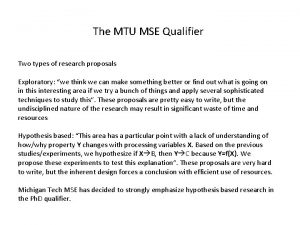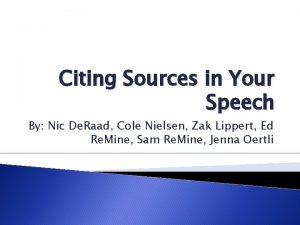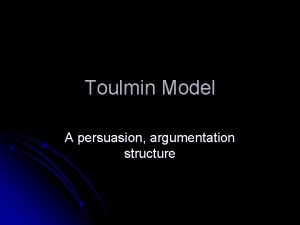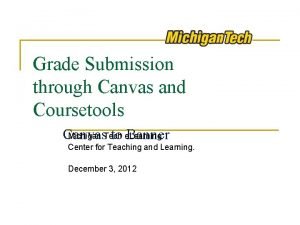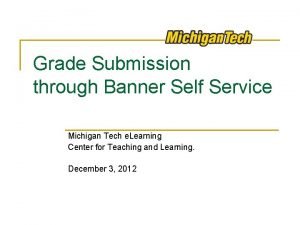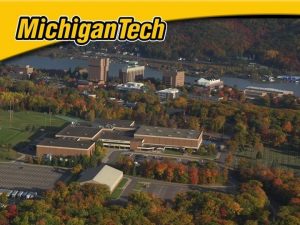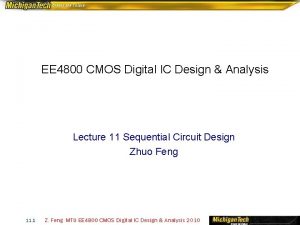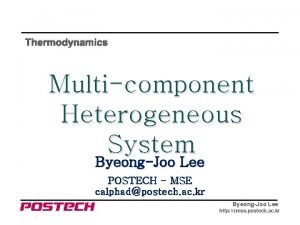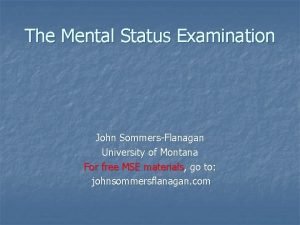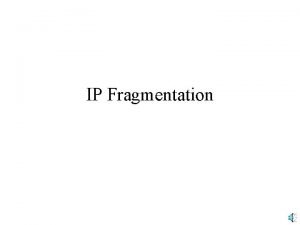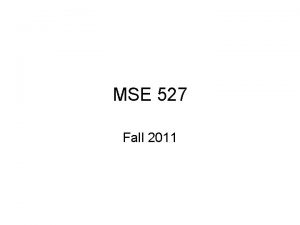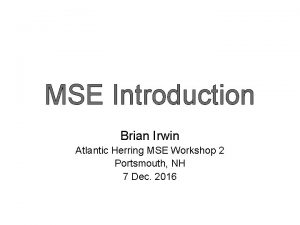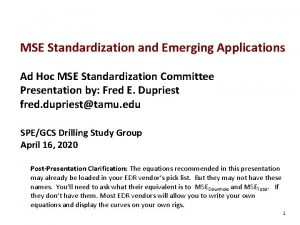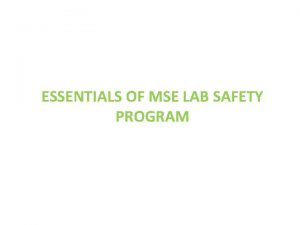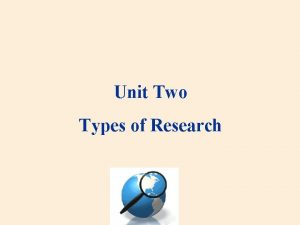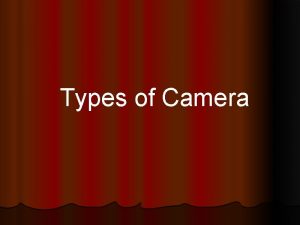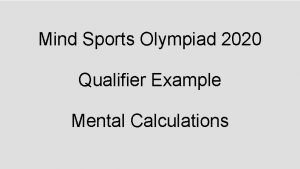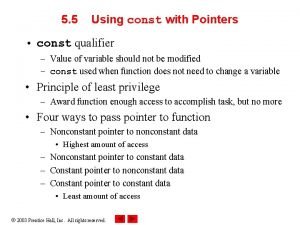The MTU MSE Qualifier Two types of research














- Slides: 14

The MTU MSE Qualifier Two types of research proposals Exploratory: “we think we can make something better or find out what is going on in this interesting area if we try a bunch of things and apply several sophisticated techniques to study this”. These proposals are pretty easy to write, but the undisciplined nature of the research may result in significant waste of time and resources Hypothesis based: “This area has a particular point with a lack of understanding of how/why property Y changes with processing variables X. Based on the previous studies/experiments, we hypothesize if X B, then Y C because Y=f(X). We propose these experiments to test this explanation”. These proposals are very hard to write, but the inherent design forces a conclusion with efficient use of resources. Michigan Tech MSE has decided to strongly emphasize hypothesis based research in the Ph. D qualifier.

Statement of Philosophy The purpose of the oral qualifying examination is for the student to show his or her ability i. ) to conduct a comprehensive literature search on a potential research area; ii. ) to synthesize the information thus obtained into a general scientific and engineering framework, incorporating additional scientific, engineering and mathematical principles as necessary; iii. ) to use that framework to devise a testable, nontrivial hypothesis; and iv. ) to design a set of experiments that may be performed to test the hypothesis. Successful completion of these points indicates that the student has an understanding of the scientific method and how to apply it to a specific research area. Prof. Doug Swenson

Wiki definition A hypothesis is a proposed explanation for a phenomenon. For a hypothesis to be put forward in science or engineering, the scientific method requires that one can test it. MTU requirements. This is a ‘checklist’!! (1) Your hypothesis must be based on previous observations from the literature or your laboratory. You should be very familiar with the previous work in the subject area of your hypothesis. (2) Your hypothesis should be couched in terms of the applicable relationships between Processing: Structure: Property that form the basis of the Materials Science field. (3) Your hypothesis should involve a mechanism of action by which basic concepts of materials science are invoked as a rigorous framework relating experimental variables to a specific prediction (4) Your hypothesis must be testable in that there is some proposed analysis or experimentation that will produce data that can be quantitatively compared to the prediction of your hypothesis (5) Your hypothesis must be non-trivial in that it cannot be a statement of the obvious to the professional audience. An example of a trivial hypothesis that we have seen may be summarized as “I hypothesize that the experiments I do will produce new results”. A trivial hypothesis will not be well received by your committee!

(1) Your hypothesis must be based on previous observations from the literature or your laboratory. You should be very familiar with the previous work in the subject area of your hypothesis. • Your hypothesis needs to be based on some observations or ideas, while at the same time it must be original. • You need to have a good familiarity with the literature related to your work. Your panel members may look at a literature search related to your proposal for a couple of hours before your presentation. You need to be aware of anything they may find. Don’t let a cursory review of the literature by your panel ‘show you up’. You can use the literature to justify your hypothesis by showing there is an open question regarding a particular phenomenon, process, design, approach etc. The hypothesis should be phrased using the structure of a proposed behavior of the type “If these parameters are varied, then this (structure: process: property) will occur because of this mechanism. • •

(2) Your hypothesis should be couched in terms of the applicable relationships between Processing: Structure: Property that form the basis of the Materials Science field. You are striving for an advanced degree in Materials Science and Engineering, so you should be able to demonstrate the ideals of the field in your proposal. The physical basis of the field is that there is a relationship between processing and structure and a relationship between structure and properties. These relationships are defined through a set of fundamental principles, such as thermodynamics, mass, heat and electron transport, nucleation and growth and coarsening theory, dislocation theory, brittle crack theory, band theory, theory of magnetism, etc. The intelligent application of these principles will allow the structure to be engineered by controlling the processing, which in turn can be used to engineer the properties (performance). An audience of Materials Engineers will expect that your hypothesis will utilize the general approach that underpins the field.

3. Mechanism of action You should be able to invoke a mechanism by which your subject of study operates. Whether it be heat/mass transport, nucleation, plasticity, dislocation theory, elasticity or solid state physics, the field of Materials Science has progressed to the point where these quantitative theories have been successfully applied to processing: structure: property interrelationships many times. Your committee will want to see you apply the applicable concepts in a quantitative fashion within the proposed hypothesis. The invocation of quantitative physical principles to construct a mechanism of action provides the advantage of illustrating how a dependent variable (some structure or property) will be a function of an independent variable (time, temperature, length scale etc. ). The resulting dependent: independent variable relationship then lets you propose experiments to vary these independent variables ‘test’ your hypothesis of how the dependent variables should respond.

(4) Your hypothesis must be testable in that there is some analysis or experimentation that will produce data that can be quantitatively compared to the prediction of your hypothesis. • Your proposed mechanism of action should be quantitative enough to allow the prediction of trends or even specific values of dependent variables as a function of independent variables. • The research that you propose should be focused on testing your hypothesis. The approach should be explained in a step by step, detailed manner. A superficial description that expects the panel to assume details of the experimental method, statistics of error and method of comparison with predictions of hypothesis may be deemed unsatisfactory. • You may want to create an experimental design matrix which shows which independent variables will be varied and over what range, and what dependent variables you intend to measure. Be realistic about how many experiments are planned. Note that parameter space can be explored in numerical models as well as in the laboratory. • If possible, a realistic assessment of error, sensitivity or statistical significance of experimental or numerical data is required. Don’t present experimental data or graphs without error analysis.

Dependent variable (4) Your hypothesis must be testable in that there is some analysis or experimentation that will produce data that can be quantitatively compared to the prediction of your hypothesis. Example (but not the only way to test a hypothesis): Hypothesis Prediction Hypothesis not true Experimental data Dependent variable Independent variable Hypothesis Prediction Experimental data Independent variable Hypothesis true (within the error of the measurement). A statistical analysis of your experiment: hypothesis comparison is a good thing to propose (with details)

(5) Your hypothesis must be non-trivial in that it cannot be explained by simple application of well known laws. Examples of Trivial Hypotheses: The observed chemical transformation from A to B occurs because there is a negative free energy change. If the liquid is cooled below the melting point, then solidification occurs because the liquid is cooled below the melting temperature. The yield stress of Al will increase when it is alloyed to make a solid solution My experiments will produce new results on the fatigue of alloys. No one has ever studied this phenomena before, and my experiments will show what is happening.

Student Question: How can I start the process of developing a testable, non -trivial hypothesis? Answer: Start by being curious. Ask the question(s) ‘why does that happen’ and/or ‘how does that happen’. If the answer to these questions is not obvious to the expert, then your attempt at formulation of a possible answer can provide a basis for a non-trivial hypothesis. Although in the end a hypothesis may be found either true or false (if it is testable), your hypothesis should always be reasonable in that it is based on the same fundamental physical principles upon which the field of materials science is based.

Materials ‘Science’ Research. Finding something new about nature. Explaining an observed phenomenon using principles of Materials Science (Thermodynamics, kinetics, dislocation theory, etc) The materials phenomenon Y is observed and is unexplained. It is hypothesized that Y=f(X), where f(X) is based on fundamental principles of materials science. A set of experiments will vary X independently of other important parameters. This will prove or disprove the hypothesis. The materials phenomenon Y is observed an unproven hypothesis is that Y=f(X). No one has been able to devise an experiment to vary X independently. If the new widget is used, then X will be varied independently because (Principle of Materials Science)

What is Materials Engineering Research? Applying the fundamental principles of Materials Science in the design of a new material, material process or widget. Process Design Hypothesis: My process design is to control the process variable X(t)=f(t). If X=f(t), then the property Y is optimized because (Principle of Materials Science). Computational Algorithm Hypothesis: The parameter (P) introduced to the algorithm improves the prediction of the real case (reality) by % because (Principle of Materials Science) See Following two slides for basis of discussion

Adapted from RESEARCH 101 FOR ENGINEERS George A. Hazelrigg 1 Nation Science Foundation What is Materials Engineering Research? Applying the fundamental principles of Materials Science in the design of a new material, material process or widget. In designing a materials process, for example, the engineer must be able to predict the behavior of the process as a function of the design choices made regarding the process. In order to affect good prediction, engineers invoke the belief that all principles of materials science apply everywhere all the time… Research regarding which principles of materials science dominate the behavior of a process is framed as an hypothesis denoting a conjecture to be tested. We observe that such an hypothesis forms the basis of research that is uniquely engineering. …a second area of research that is uniquely engineering is finding computational algorithms that provide adequate representations of the real cases… Research on this topic can also be framed as an hypothesis, notably that a particular algorithm provides a representation of reality within a specified error bound. And, again, this area of research fits our criteria as uniquely engineering.

Example: Engineering Research: Materials Process/Design Optimization Hypothesis Formulation and Testing
